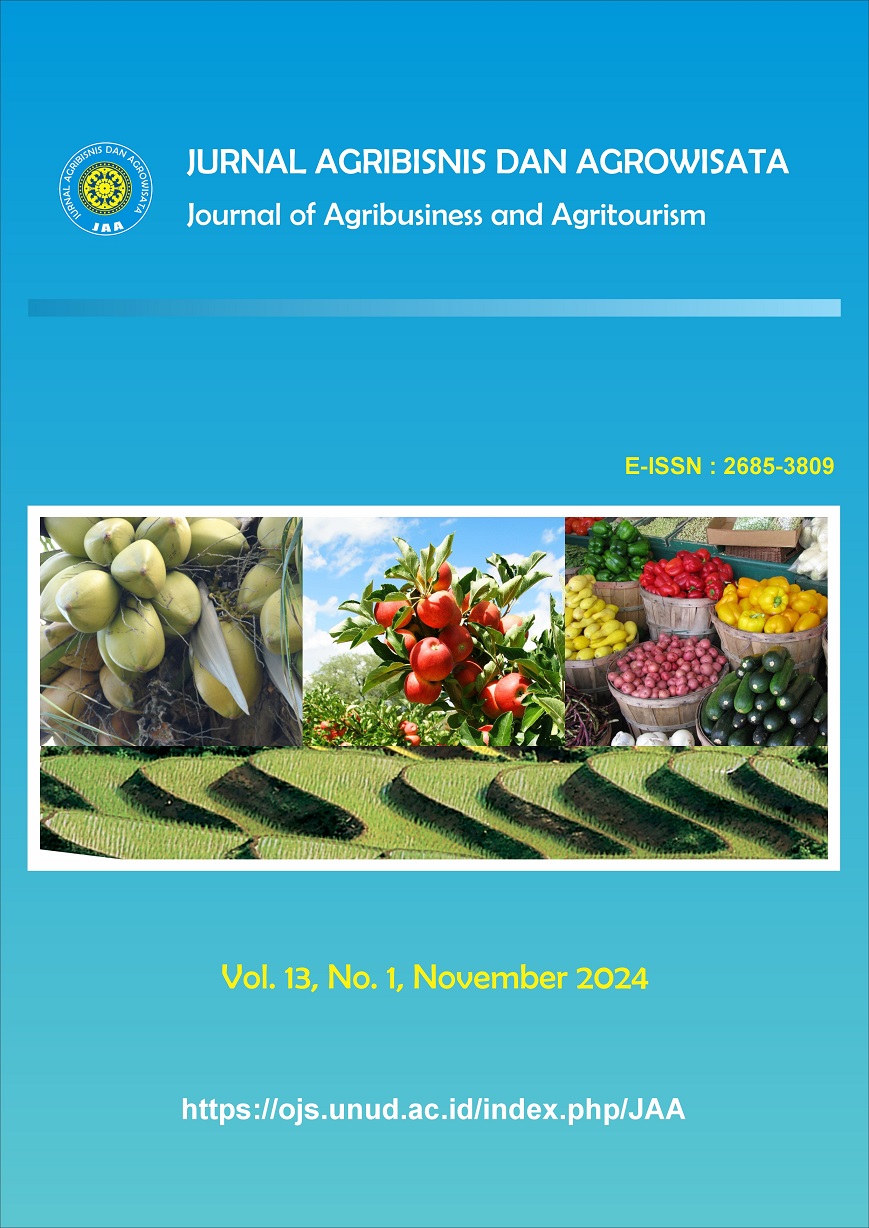Valuasi Ekonomi Perhutanan Sosial Hutan Pinus di Desa Adat Glagalinggah, Kecamatan Kintamani, Kabupaten Bangli
Abstract
Economic Valuation of Pine Forest Social Forestry in Glagalinggah Traditional Village, Kintamani District, Bangli Regency. The natural resources of Pine Forest in Glagalinggah Traditional Village have potential economic value, ecological, social and cultural functions but not all of them have market value so that economic valuation needs to be done. This study aims to identify the types of use value and non-use value found in Pine Forest in Glagalinggah Traditional Village and analyze the use value, non-use value and total economic value of Pine Forest in Glagalinggah Traditional Village. This research was conducted for 3 months in the Pine Forest area in Glagalinggah Traditional Village. The data collection methods used were observation, interview, and literature study. The method used in this research is the economic valuation method and is analyzed using descriptive qualitative and descriptive quantitative analysis. The results showed that (1) The types of use value owned by Pine Forest in Glagalinggah Traditional Village are direct use value, indirect use value and optional value. Types of direct use value in the form of elephant grass, adopted trees, wood and pine resin, as well as tourism and recreation activities. Indirect use values include roraks, bamboo trees and banyan trees as erosion barriers and carbon sequestration. Selected values refer to the biodiversity within the pine forest. Meanwhile, the types of non-use values owned by Pine Forest in Glagalinggah Traditional Village are existence value and heritage value. (2) The use value of pine forest in Glagalinggah Traditional Village is Rp37,611,720,300/year (99.09%), and the non-use value of pine forest in Glagalinggah Traditional Village is Rp346,839,870/year (0.91%). (3) The total economic value of pine forests in Glagalinggah Traditional Village is Rp37,958,560,170/year.
Downloads
References
Anestiningarum & Prasetyo, N. 2023. Persepsi Masyarakat terhadap Jasa Lingkungan Berbasis Hutan: Studi Kasus Hutan Pinus Precet, Kabupaten Malang, Jawa Timur. Journal of Forest Science Avicennia, 06(02), 188– 197.
Fauzi, Darusman, D., Wijayanto, N., & Kusmana, C. 2011. Analisis Nilai Ekonomi Sumberdaya Hutan Gayo Lues. Jurnal Hutan Dan Masyarakat, 6(1), 13–20.
Ibrahim, M. A., & Hassan, M. 2023. Economic Valuation of Forest Services: Case Study of Zawita Forest, Kurdistan Region of Iraq. Journal of University of Duhok, 26(1), 1–13.
Kementerian Lingkungan Hidup. 2012. Peraturan Menteri Negara Lingkungan Hidup Republik Indonesia Nomor 15 tahun 2012 tentang Panduan Valuasi Ekonomi Ekosistem Hutan.
Peraturan Menteri Lingkungan Hidup dan Kehutanan RI. 2021. Peraturan Menteri Lingkungan Hidup dan Kehutanan Republik Indonesia Tentang Tata Hutan dan Penyusunan Rencana Pengelolaan Hutan, serta Pemanfaatan Hutan di Hutan Lindung dan Hutan Produksi (Nomor 8 Pasal 1 Ayat 1 Tahun 2021).
Ruitenbeek, H. J. 1991. Mangrove Management: An Economic Analysis of Management Options With a Focus on Bintuni Bay, Irian Jaya. School for Resource and Environmental Studies, Dalhousie University.
Siyoto, S., & Sodik, M. A. 2015. Dasar Metodologi Penelitian. Literasi Media Publishing.
Sultan, Hassanuddin, Husnah, L., Nur, A. 2019. Nilai Serapan Karbon Hutan Pinus di Desa Pesse Kecamatan Donri-Donri Kabupaten Soppeng. Jurnal Penelitian Kehutanan Bonita. 32–36.
Tajuddin, T. 2021. Pemanfaatan Getah Pinus dan Perannya Terhadap Penghidupan Masyarakat di Provinsi Sulawesi Selatan. ULIN: Jurnal Hutan Tropis, 5(1), 9.







